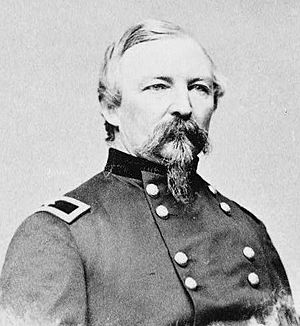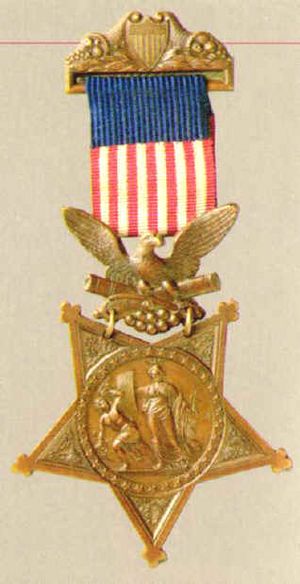John Porter Hatch facts for kids
Quick facts for kids
John Porter Hatch
|
|
|---|---|

John Porter Hatch
|
|
| Born | January 9, 1822 Oswego, New York |
| Died | April 12, 1901 (aged 79) New York City, New York |
| Place of burial | |
| Allegiance | United States of America Union |
| Service/ |
United States Army Union Army |
| Years of service | 1845–1886 |
| Rank | |
| Unit | |
| Commands held | Cavalry, V Corps 1st Division, I Corps 2nd U.S. Cavalry |
| Battles/wars | Mexican–American War American Civil War |
| Awards | Medal of Honor |

John Porter Hatch (born January 9, 1822 – died April 12, 1901) was an American soldier. He served as a general in the Union Army during the American Civil War. He earned the Medal of Honor for his bravery. This award was given for his actions in September 1862. It happened during the Battle of South Mountain in the Maryland Campaign.
Early Life and Army Start
John Porter Hatch was born in Oswego, New York. His parents were Moses Porter and Hannah (Reed) Hatch. He went to the United States Military Academy and finished in 1845.
His first experience in the army was as a second lieutenant. He served in the 3rd U.S. Infantry during the Mexican–American War. In May 1846, he fought under General Zachary Taylor at Palo Alto and Resaca de la Palma. Later, he joined the Mounted Rifles under General Winfield Scott. He was given a temporary higher rank of first lieutenant for his brave service. This was during the battles of Contreras and Churubusco. He was also given a temporary rank of captain for his courage at Chapultepec.
After the war, Hatch was sent to different army posts. Many of these were in the American West and in Oregon. In 1851, he married Adelaide Goldsmith Burckle. They had two children together. Over the next ten years, Hatch took part in several missions involving Native American groups. In October 1860, he was promoted to the full rank of captain. He then became the Chief of Commissary for the army's Department of New Mexico. This meant he was in charge of army supplies.
Service in the Civil War
When the Civil War began, Hatch was sent East. He joined the cavalry under General George B. McClellan. On September 28, 1861, he became a brigadier general of volunteers. In December, he was given command of a cavalry brigade in Annapolis, Maryland. This brigade served under General Rufus King. Hatch's brigade carried out daring raids on enemy positions. These raids were near the Rapidan and Rappahannock rivers. Because of these raids, his brigade earned the nickname Iron Brigade.
In March 1862, Hatch took command of the cavalry for the V Corps. This was under Major General Nathaniel P. Banks. He served in the Valley Campaign and fought at the First Battle of Winchester. In August of that year, he was moved to the infantry. This happened after some disagreements with army commander John Pope. Hatch then commanded a brigade in the I Corps. He took over command of a division when Brigadier General Rufus King became ill. This was just before the Second Battle of Bull Run. Hatch led the division in that battle and at the Battle of South Mountain. During the Battle of South Mountain, he was shot in the leg. For his bravery under heavy enemy fire, he received a temporary promotion to major general of volunteers. He also received the Medal of Honor.
Hatch was injured and couldn't fight until February 1863. He then returned to lighter office jobs. He served as a judge in military trials. In July, he commanded the draft meeting point in Philadelphia. Later that year, he commanded the cavalry supply center in St. Louis. On October 27, 1863, he was promoted to the permanent rank of major in the Regular Army. He joined the 4th U.S. Cavalry.
In 1864, he was assigned to the Department of the South. Here, he was in charge of the coast division. He led operations on John's Island, South Carolina, in July. In November, he led the Union forces at the Battle of Honey Hill. After this, he worked with Major General William T. Sherman. They were part of the Georgia-Carolinas Campaign. Hatch also took part in the attack on Charleston. After the city surrendered, Hatch was in charge of its military command from February to August 1865. After the war, he received several group promotions. He was made a major general of volunteers and a colonel in the Regular Army.
After the War
John Porter Hatch stayed in the regular army after the war. He went back to his permanent rank of major. For the next twenty-six years, he served again on the frontier. In 1873, he was promoted to lieutenant colonel. Eight years later, he became a colonel of the 2nd U.S. Cavalry. In 1881, while still a lieutenant colonel, Hatch was moved from Fort Elliott in Mobeetie, Texas. The people living there were sad to see him go. On July 4 of that year, the Wheeler County Commissioners Court honored Hatch. They thanked him for his service at Fort Elliott. They said he was always helpful to the citizens.
Hatch also served as an officer at Fort Concho in San Angelo, Texas. He also worked in Indian Territory, Montana Territory, and Washington Territory.
He retired from the army on January 9, 1886. He then moved to New York City. In 1893, he officially received the Medal of Honor for his bravery at South Mountain. Hatch was the President of the Aztec Club of 1847 of New York. He was also a member of the Oswego County Historical Society.
John P. Hatch passed away in New York City in the spring of 1901. He was buried at Arlington National Cemetery, Arlington, Virginia. He was survived by his wife, Adelaide Burckle Hatch (1825–1919). He was also survived by their children, Miss Harriet Hatch (1854–1929) and Mark Burckle Hatch (1856–1914).

